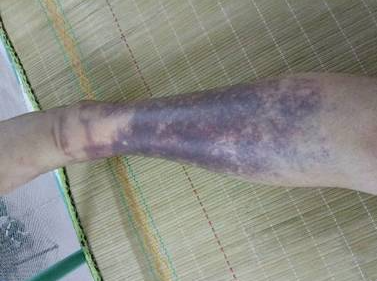
You’re getting dressed one morning and notice a dark purple blotch on your shin. You wrack your brain, but you can’t remember bumping into anything. It’s odd, but you shrug it off. A week later, it’s still there, and a new one has appeared a few inches away. These aren’t the familiar yellow-green bruises healing from a known tumble; they’re persistent, unexplained, and seem to favor your shins.
It’s easy to dismiss this as just another quirk of getting older—thinner skin, more fragile capillaries. And while that can be part of the story, when bruises appear without injury and are slow to heal, your body is signaling something more significant. It could very well mean your blood platelets are dangerously low or malfunctioning.
Let’s pull back the curtain on what’s happening beneath the skin.
The Leaky Pipe Analogy: The Role of Platelets
Think of your vast network of blood vessels as an intricate plumbing system. Tiny, invisible leaks happen all the time from minor stresses and strains. Platelets are your body’s emergency repair crew. These tiny, sticky cell fragments constantly patrol your bloodstream. At the first sign of a leak, they swarm the site, clumping together to form a temporary plug—the first and most critical step in stopping bleeding and forming a bruise.
When your platelet count is low (a condition called thrombocytopenia) or when the platelets are present but not functioning properly, this repair system breaks down. A tiny leak that should have been sealed in minutes continues to seep blood into the surrounding tissue. The result is a bruise that forms without a memorable injury and lingers because the underlying leak was never properly patched.
Why This is a Red Flag You Can’t Ignore
Unexplained bruising on the shins is a particular red flag because the legs are far from the heart, and blood flow and pressure in the lower extremities can make these tiny vessels more susceptible to leaks. When your body can’t keep up with the repairs, it points to a systemic issue. Here’s what could be going wrong:
- Your Bone Marrow Isn’t Producing Enough Platelets. The bone marrow is the factory where all blood cells, including platelets, are made. Conditions like leukemia, aplastic anemia, or certain viral infections can suppress or crowd out the marrow’s ability to produce these crucial cells. The bruises on your shins are a visible sign of a production crisis happening deep within your bones.
- Your Body is Destroying Platelets Faster Than It Can Make Them. This is the mechanism behind Immune Thrombocytopenia (ITP), an autoimmune disorder where the immune system mistakenly identifies platelets as foreign invaders and attacks and destroys them. The bruises are the evidence of this internal civil war.
- Your Platelets Are Being Consumed by Clots. In rare cases, a condition called Thrombotic Thrombocytopenic Purpura (TTP) causes widespread microscopic blood clots to form, using up vast numbers of platelets and leaving too few to perform their daily repair work.
- Your Platelets Are “Drunk” and Malfunctioning. Sometimes, the platelet count is normal, but the cells themselves don’t work. This can be caused by certain medications (like aspirin or blood thinners), kidney disease, or even Vitamin B12 or folate deficiency, which are essential for producing healthy blood cells.
What to Do When You See the Signs
This is not a time for a “wait-and-see” approach. Those unhealed bruises are a request for a diagnostic investigation.
- Schedule a Doctor’s Appointment Immediately. Don’t downplay it. Tell your doctor, “I’m developing persistent bruises on my shins without any injury, and I’m concerned about my platelet levels.”
- Demand a Complete Blood Count (CBC). This simple blood test is the first and most critical step. It will immediately reveal your platelet count and provide a wealth of other information about your red and white blood cells.
- Look for Other Symptoms. Be prepared to tell your doctor if you’ve also noticed:
- Pinpoint red or purple spots on the skin (petechiae), which look like a rash but don’t blanch when pressed.
- Unusual bleeding from your gums when you brush.
- Frequent nosebleeds.
- Heavier-than-normal menstrual periods.
- Unusual fatigue (which could point to anemia).
Those mysterious bruises on your shins are more than just marks; they are a bulletin from your bloodstream. They are your body’s way of showing you that its most fundamental repair system is failing. By seeking an answer, you’re not just solving a cosmetic mystery—you are taking a vital step to ensure the integrity of the very river of life that flows within you.